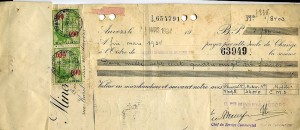
Investorwords.com defines a bill of exchange in the following terms:
An unconditional order issued by a person or business which directs the recipient to pay a fixed sum of money to a third party at a future date. The future date may be either fixed or negotiable. A bill of exchange must be in writing and signed and dated.
Essentially, a bill of exchange is an order to pay the bearer of the bill. Again, we’ll look to concrete examples to help illustrate the process: when a trader in Mozambique sells a commodity item to a buyer from South Africa (perhaps Dr Frank purchases PC components from a Mozambican friend), he draws a bill on the buyer which instructs a financial institution to pay the bearer of the bill the amount specified on the due date.
The bill drawn from Dr Frank, when presented at the relevant bank, is an order for the bank to pay the bearer (or named beneficiary) the sum of x in the relevant currency. If the bill is drawn from a well-established financial institution the Mozambican trader can receive his payment either immediately, or as soon as he presents the bill to the bank. Bills are usually made payable 2, 3 or 6 months after “sight”: that is, after it has been received by the institution on which it is drawn and accepted as a legitimate bill by that institution (for the bill to be accepted, it has to be signed on its front side to indicate that the institution will indeed pay the amount due).
When the bills are accepted, they constitute promises to pay the bearer. If an issuing institution is well-established and has a good credit rating, the bank will pay the bearer the amount specified. It is thus that bills of exchange drawn from highly rated institutions are considered by banks as investments. If the issuer of the bill is a foreign company, for example, then the holding of the bill could be seen as a foreign investment.
At this point it might be useful to quote Wikipedia.com concerning the definition of the bill of exchange:
A bill of exchange or “draft” is a written order by the drawer to the drawee to pay money to the payee. A common type of bill of exchange is the cheque, defined as a bill of exchange drawn on a banker and payable on demand. Bills of exchange are used primarily in international trade, and are written orders by one person to his bank to pay the bearer a specific sum on a specific date. Prior to the advent of paper currency, bills of exchange were a common means of exchange.
Bills of exchange are used in foreign transactions, and can be deposited into local bank accounts at current exchange rates, although the funds may only become available after a specified waiting period. Bank charges will almost certainly also be charged.
In terms of the global market place, English issued bills of exchange are considered to be highly reliable, and are therefore used as a form of global currency for trade between nations (even when neither of those countries are England). It should also, at this point, be evident that bills of exchange are “negotiable” unless otherwise stated. This means that bills, because they are seen to have inherent value, can be used as a store of value and can be traded. The bill that is presented for payment might have passed through several hands before it reaches a bank. If the bill is traded for less than its value, it is said to trade at a discount, and if it trades for more it said to trade at a premium.
As previously stated, finance is an enormously powerful tool for the development and refinement of industry, and can potentially be beneficial to society as a whole rather than just to those directly involved in the process.
You were visited with an excellent idea